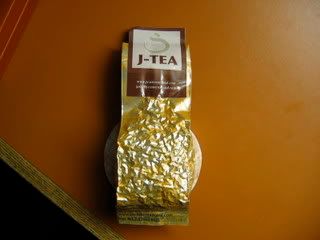
Ah, the time has come to review a tea that can be made readily available for purchase, J-Tea International's Green Spring Oolong.
A note about myself: As you have undoubtedly noticed by now, I'm a green variety of tea-addict. As a result of this, whenever I shop for tea, I look for green, and I look for cheap. My purchase of this tea is a direct result of this. As I searched through the J-Tea teas, I rooted out the greenest, then selectively considered the cheaper two, and then determined the vacuum sealed bag to be preferable.
And thus:
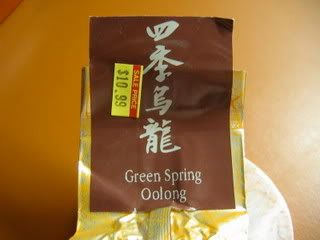
The bag is very nicely sealed, with no air in the package, and no light allowed to hurt the little greens within. The use of scissors and a swift hand movement allowed the spilling.
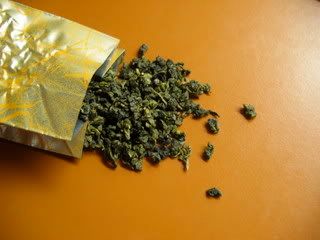
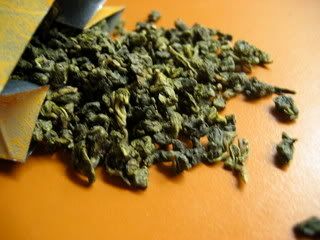
The dried leaves give off the common sweet smell associated with green oolongs, yet accompanying this common smell was an odd one. Also noted is a hint of an earthen-graham smell. The odd undertone was that of floral astringency: the everyday light floral tone had been marked by an almost salty astringency, leaving a quite intriguing smell, one that I hoped would develop in the steeping process (for sake of tasting something so intriguing).
Here's the 80g bag and some rolled up leaves next to a DVD for comparison:
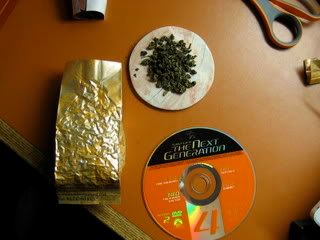
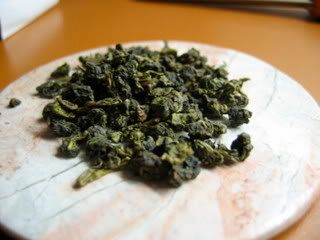
A very nice looking green oolong, which has unavoidably made me a bit thirsty...
My preferred way to drink a green oolong at the time is with my trusty glass cup and infusor cup. Combined with a measuring teaspoon and a thermometer, this is a very convenient way to drink a big glass of tea.

There it is, hot water already added.
Then we measure about 1.5 teaspoons of tea per cup, place the rolled leaves into the glass infusor.

After that, one needs only to put the infusor into the cup and let it do it's job.

After about 30 seconds:
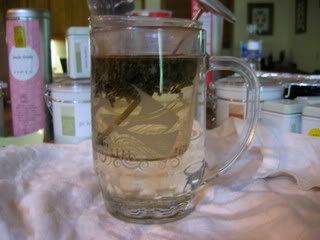
And here it is, after four minutes of steep-time.

Then we take out the infusor, press the leaves into the side over the cup to let out as much tea as possible (in order to have good subsequent infusions, we must get as much water out of the leaves as possible. The method I use is to first squeeze the leaves, then move them around in the infusor while blowing on them).
And the final product...

As it is normally very hard to match the color of tea in the pictures to the actual color (especially in a glass cup), many photos of tea you will see online will not be accurate depictions of the color of the tea, I took plenty of time to make sure this one was 99% accurate.
During the first steeping, the leaves aren't given much time or heat to expand, so they are still left slightly curled:

A note about myself: A big problem with these wet leaf pictures is that people pick out the better/best looking leaves from the infusion. What I'm trying to do is to give the most accurate depiction of what is actually supplied from the tea shops. Because I believe that my readers should receive the most accurate information, the tea leaves wont always be the most aesthetically pleasing, but they will be the most accurate.
Even after the second infusion, the leaves are not fully opened, yet many large leaves have been exposed:



And more from another day:


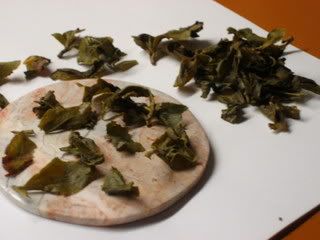
After the second steeping, the leaves look fairly nice. Not amazing, but not really bad at all. I did find a tad bit of brown in two of the leaves though, yet thats two out of what could be 50 or more.
Here's a fairly accurate depiction after the first steeping:
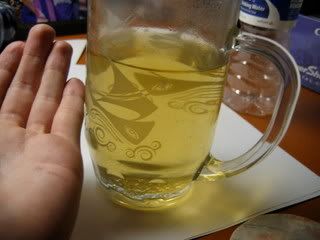
The smell of the steeped infusion is that of a sweet, floral cream. Mellowly smooth, devoid of anything resembling bitterness, and predominantly a sweet, green oolong. However, interestingly enough, the faint floral astringency is still lurking in undertones.
Sipping on the tea at a lower temperature of around 150°f allows one to identify a wider palate of tastes. As the tongue first meets with the tea, the taste is nothing but a creamy, smooth-sweet liquid, which immediately is followed by the mellow, greener, floral notes of honey. Thick and rich, this tea is able to induce much salivation during it's consumption. While smelling the faint floral astringency, the sides of the tongue pick up it up, only to be greatly surprised by the lack of the salty astringency, finding there only to be the open floral notes and a seperate light, breezy astringency. As the temperature of the tea reaches the optimal 115°f, we are left with nothing but the honey-sweet, light florally green taste. This is the taste which is desired in a light oolong.
In conclusion, there is very little to dislike about this tea. In fact, my only disappointment was not being able to taste the so intriguing "floral astringency." I feel, however, that the tea is better without it. The light breezy astringency that is present in the taste only adds to the character of the tea, making it quite original.
They say first impressions are the most important, which is good for J-Tea, because this tea has left me with no complaints. More reviews of J-Tea's products can be expected in the future, for J-Tea has proven, thus far, to be the local quality teashop.
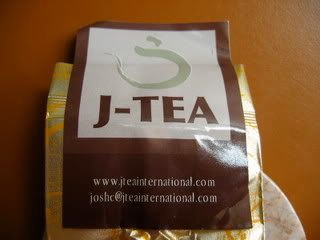
J-Tea's products can be found at http://www.jteainternational.com/
If you would like for me to do a review of another one of his greener oolongs, shoot a note to thegreenteaman@gmail.com and I'll see what I can do.


3 comments:
Wow! That's a freaking awesome review! I really like the step by step photos, and the additional explication is great too! I'd like to hear more about these green oolongs if you have a chance.
Yes, I am loving the picture slide. Keep this up.
I read your review and got some oolong from J-Tea. I was not disappointed. It was excellent. Keep up the most informative reviews. I look forward to trying more tea in the future. Rick
Post a Comment